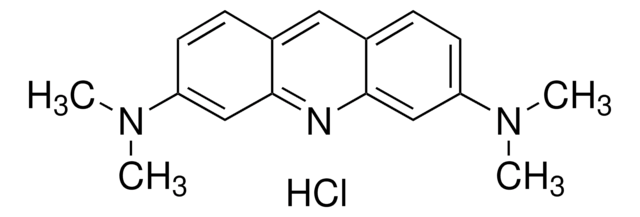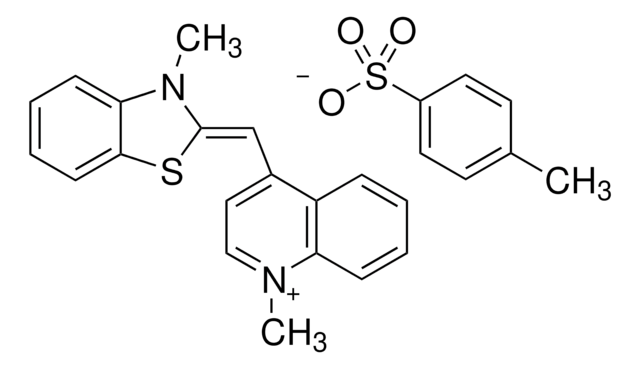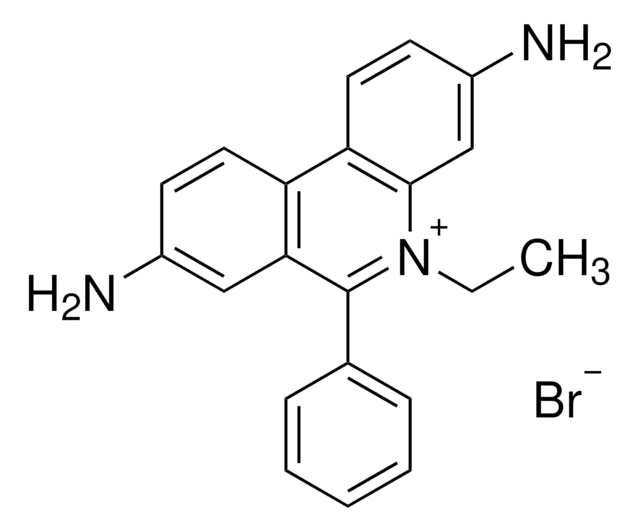A9231
Acridine Orange solution
2% in H2O
Synonym(s):
3,6-Acridinediamine, N,N,N′,N′-tetramethyl-, monohydrochloride, 3,6-Bis(dimethylamino)acridine hydrochloride
Sign Into View Organizational & Contract Pricing
All Photos(1)
About This Item
Empirical Formula (Hill Notation):
C17H19N3 · HCl
CAS Number:
Molecular Weight:
301.81
MDL number:
UNSPSC Code:
12171500
PubChem Substance ID:
NACRES:
NA.47
Recommended Products
form
liquid
Quality Level
shelf life
18 mo.
concentration
2% in H2O
technique(s)
microbe id | staining: suitable
application(s)
diagnostic assay manufacturing
hematology
histology
storage temp.
2-8°C
InChI
1S/C17H19N3/c1-19(2)14-7-5-12-9-13-6-8-15(20(3)4)11-17(13)18-16(12)10-14/h5-11H,1-4H3
InChI key
DPKHZNPWBDQZCN-UHFFFAOYSA-N
General description
Acridine Orange (C.l. 46005) is an acridine dye with a ring structure and overall small planar conjugated system.
Application
Acridine orange is a DNA intercalating dye that is a recommended DNA stain for flow cytometry. It differentially stains double-stranded and single-stranded nucleic acids.
It also has the following applications-
It also has the following applications-
- staining of RNA and acid mucins
- detecting apoptosis
- staining blood smears to diagnose malaria
- identifying and enumerating granulocytes in fish
- staining eukaryotic cells to demonstrate low pH structures
Storage Class Code
10 - Combustible liquids
WGK
WGK 2
Flash Point(F)
Not applicable
Flash Point(C)
Not applicable
Personal Protective Equipment
dust mask type N95 (US), Eyeshields, Gloves
Choose from one of the most recent versions:
Already Own This Product?
Find documentation for the products that you have recently purchased in the Document Library.
Customers Also Viewed
Matthew P Harris et al.
PLoS genetics, 4(10), e1000206-e1000206 (2008-10-04)
The genetic basis of the development and variation of adult form of vertebrates is not well understood. To address this problem, we performed a mutant screen to identify genes essential for the formation of adult skeletal structures of the zebrafish.
Grace Emily Okuthe
Acta histochemica, 115(2), 178-184 (2012-07-17)
Oogenesis involves a sequence of cellular divisions and developmental changes leading to the formation of oocytes, whose role in development is to transfer genomic information to the next generation. During this process, the gene expression pattern changes considerably concomitant with
Hong-xiang Wang et al.
Zhonghua yi xue za zhi, 92(26), 1828-1831 (2012-09-05)
To ascertain the epididymal sperm nuclear maturity in obstructive azoospermia (OA) patients. A total of 81 infertile males from andriatry clinic of Renji hospital were selected, including 32 OA patients (OA group) and 49 asthenospermia patients (asthenospermia group). Another 32
Leo Li-Ying Chan et al.
Journal of immunological methods, 388(1-2), 25-32 (2012-12-04)
Peripheral blood mononuclear cells (PBMCs) have been widely researched in the fields of immunology, infectious disease, oncology, transplantation, hematological malignancy, and vaccine development. Specifically, in immunology research, PBMCs have been utilized to monitor concentration, viability, proliferation, and cytokine production from
Dolar Pak et al.
Journal of environmental science and health. Part. B, Pesticides, food contaminants, and agricultural wastes, 48(6), 512-515 (2013-03-05)
In this study we assessed the use of acridine orange as an alternative to optical density to quantify the growth of Lactobacillus bulgaricus ATCC 7517. The growth of bacteria in Lactobacillus de Man Rogosa Sharpe (MRS) medium was measured by
Our team of scientists has experience in all areas of research including Life Science, Material Science, Chemical Synthesis, Chromatography, Analytical and many others.
Contact Technical Service









